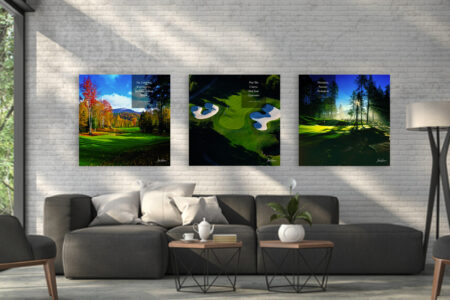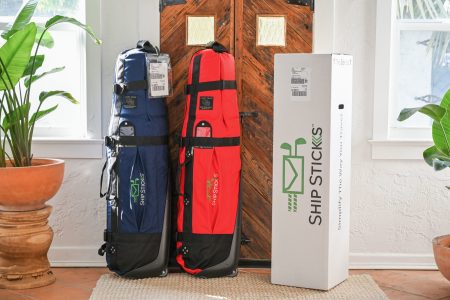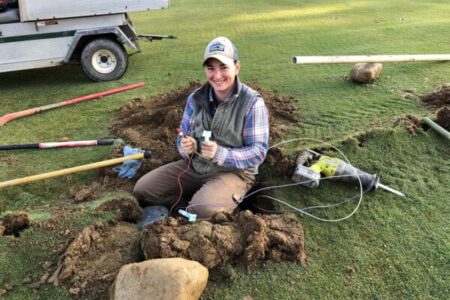David Postlethwait always wanted to build a first-rate, lighted par-3 golf course.
For 20 years, the course designer who got his start on the construction crew working under Pete Dye and helped bring the TPC concept to life as a staff member of the PGA Tour, tried to put together a deal. On the fifth go-round in 1998, Postlethwait succeeded in building Knight’s Play Golf Center in Apex, North Carolina, a 27-hole facility near Raleigh that has turned into everything he dreamed it could be.
“I worked it hard,” he said. “I’m pretty persistent.”
Knight’s Play opened with 18 lighted holes in 1998 and did 60,000 rounds in the first year, leading Postlethwait to build another nine. Four years after opening, it surpassed 100,000 rounds, and they’ve now leveled off at about 80,000 annually.

Golfers line up putts under the lights at Knight’s Play in North Carolina. (Photo courtesy of Knight’s Play)
Postlethwait sold his stake in 2011 and retired, but remains a big believer that lights could be viable for some owners and operators today – whether in the form of a fully-lighted course, nine holes, the final three holes or some other variation.
“Do I think it would be successful in a lot of other parts of the country? Yes. Hell, yes,” Postlethwait said. “I don’t know why more haven’t done it.”
Soccer, baseball and football fields are often lit late into the night, he argued, so why not a golf course? Postlethwait’s idea of lighting a course wasn’t a new one – Whitten recalls playing Westwood Golf Course, a nine-hole par-3 course in Omaha, Nebraska, as a 16 year old in 1966. The course remains open, but the lights are long gone.

Night play at Knight’s Play, one of more than 50 lighted golf facilities across the U.S. (Photo courtesy of Knight’s Play)
Others still remain and claim offering nighttime golf gives them a competitive advantage. Golf Advisor cites 56 lit facilities in the U.S., with California leading the way with 12 while another year-round golf state, Florida, has nine. Heartwell Golf Course in California, a 2,143-yard, par-3 course in Long Beach, California, is where Tiger Woods got his start.
“It was lit at night, just like most of the people who were there,” Woods once cracked.
Topgolf, where lights are an integral part of nighttime engagement, just announced that it will be adding lights as part of the renovation of a nine-hole municipal golf course (The Lakes at El Segundo) at its first venue in Southern California. The traditional golf course sits directly next door to the site for the planned golf-entertainment complex.

Topgolf’s first planned golf-entertainment venue in Southern California will have a lighted 9-hole municipal course next door.
Another night-golf venue is “Cloud 9,” a short course at Angel Park Golf Club in Las Vegas that replicates 12 of the most famous approaches in golf and was recently named among the best par-3 courses in America by Golf.com. Nine of the 12 holes are lighted for night-time play, as is a nine-hole, natural grass putting course at the facility that features bunkers, rock outcroppings and water hazards.
International Play
At least eight different countries outside the U.S. feature lighted courses and all share one common trait: providing a late night outlet for golf in regions where the temperatures soar.
Charles Biele, CEO of Emaar, The Economic City, the body responsible for the development of KAEC and Royal Greens Golf and Country Club, which opened in Saudi Arabia in 2018, said floodlights for the back nine and practice range provide a better customer experience during the hottest months and drive incremental revenues to the golf club.
Regnum Carya Golf & Spa Resort, home of the Turkish Airlines Open from 2016-18, is the first fully flood-lit golf course in Europe and in 2018 South Africans Brandon Stone and Haydn Porteous played the last three holes live on Facebook in a three-hole “Night Golf Challenge.” Meanwhile, the Ladies European Tour went one step further by holding the Omega Dubai Moonlight Classic, the first professional day-night golf tournament, on the Faldo Course at Emirates Golf Club.

The Faldo Course is the only floodlit course in Dubai. (Photo courtesy of the Dubai Emirates Golf Club)
The Faldo Course is the only floodlit course in Dubai. Lights were installed to increase usability, particularly during the obscenely hot summer months, and is typically open from 6:30 am to midnight. Gareth Williams, Director of Design and Operations at Faldo Design, says the course does 65,000 rounds per year, making it the one of the most popular in the region.
Steven Outlaw, a former assistant head professional at Abu Dhabi Golf Club, which consists of nine flood-lit holes, said the club averaged 50-60 rounds per night, with 80-90 being a good night. Food and beverage sales soared, but the added expense involved in lighting three, six or nine holes can be a deterrent.
With 352 halogen light bulbs using 2.2 kilowatts on 137 light poles, Abu Dhabi’s course is charged 348 Arab Emirates Dirham (AED), or almost $100, per kilowatt hour. Postlethwait says the electricity bill at Knight’s Club amounted to $150,000 annually, but as additional technologies emerge, lighting of golf courses continue to be more cost effective.
As part of the sustainability practices of the Saudi Golf Federation and Royal Greens Golf Club, the course will be converting the existing flood lights to LED which will not only provide better lighting for golfers, but also reduce energy usage and the carbon footprint by over 40 percent, Biele said.

NGF research shows that 50% of golfers express an interest in playing golf at night. (Photo courtesy of the Dubai Emirates Golf Club)
Golf After Dark
With the success of off-course golf experiences such as Topgolf and Drive Shack proving that golfers enjoy playing under the lights and will pay a premium for night-time entertainment, we may be at the start of a golden age for golf after dark.
The planned Topgolf facility in El Segundo is an interesting step, but why such lighted courses haven’t gained greater traction is understandable for several reasons.
For starters, it’s expensive to install and run lights. Staff costs increase when you keep a course open later. Many communities have light ordinances or zoning restrictions that regulate usage after dark. In certain parts of the country, the weather makes night golf a non-starter. It’s also tricky to schedule maintenance work when the course is practically always in use. And perhaps most importantly for their financial feasibility, many locations lack the critical mass of golfers to justify remaining open after hours.
The reasons why night golf would add incremental revenue seem just as obvious. As Postlethwait pointed out, “a lot of golfers and people who wished they were golfers work during the day.”
NGF research supports his assertion, finding that 50% of golfers express some interest in playing at night on a course, whether under lights or with glow balls. Yet only 23% have ever done so. Likewise, almost 40% of golfers with interest in playing at night say they expect they’d play more frequently if they had such an outlet available to them and, on average, would be willing to pay $8 to $10 more.

Hitting a tee shot under the lights at a golf course in South Korea.
Outlaw has seen lighted golf work stateside too, at his current job as head professional at Wickenburg Ranch Golf and Social Club in Arizona, which blends golf and entertainment.
The Watering Hole is the nucleus of this nine-hole short course named L’il Wick, set on a peninsula of the waterway that connects several holes. Speakers pump music throughout the course, and the final four holes and putting green are lighted. A full-service bar and grill serve up tasty delights for patrons watching the golfers or sports on TV screens. It’s an entertainment oasis for members and guests alike, who take part in games such as Friday Night Lights, a four-hole, two-person scramble, and take aim at a canoe in a lake that serves as a target for pitch shots with floating balls.
Then there is Wisconsin’s Erin Hills, where course designer Dana Fry has created a putting course named Drumlin. It’s 63,000-square-feet of fun with indirect lighting so guests can putt in the evening, allowing for friendly after-dinner competitions.
And more versions of night golf are in the works. Golf course architect Erik Larsen says he is conceptualizing with two premier resort properties in South Florida on a “Topgolf-type space” on existing holes that would be capable of creating incremental revenue.
Larsen said resorts make sense for night golf because it has a natural audience that is looking for evening entertainment. He envisions a fresh take on the lit driving range where tees and targets located conveniently near a clubhouse offer an alternative golf option for after work and nighttime play. It likely will consist of closest-to-pin contests and par-3 shootouts with food and beverage stations and music. It would also serve as an interim step to get non-golfers on to a course.
“We’re going to create golf fun spots as a response to trends in golf,” he said. “You can see the success of Topgolf and Drive Shack. Why not have a more intimate, luxurious and special product just in a different format?”
In October 2018, Indian Wells Golf Resort launched an after-dark golf and entertainment experience called Shots in the Night, with glow balls and inflatable lit-up bowling pins that make sounds and change colors when struck with a golf ball.
“It’s cosmic bowling combined with the playability of mini-golf, mixed with an outdoor night club atmosphere,” Indian Wells Golf Resort general manager Steve Rosen said.
As some in the golf world begin to see the light, will other facility owners and operators follow suit?
Top image: Regnum Carya Golf & Spa Resort in Turkey



